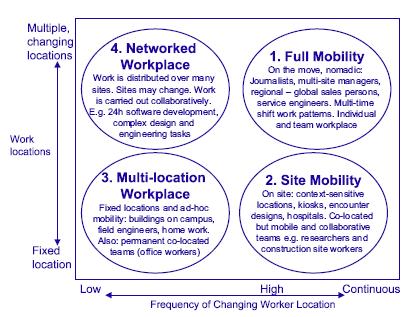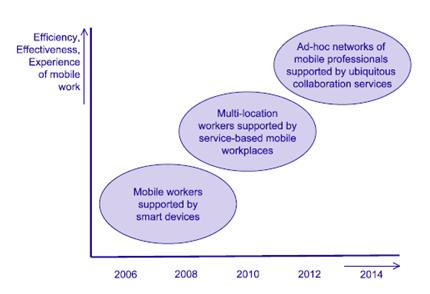Dynamic Mobile Workspace
Introduction:
The widespread use of mobile communications is leading to new practices in family life, social life, and corporate life. These changes have significant implications for the study of the adoption of new modes of space-time coordination, changing time use and increasing mobility, the blurring of boundaries between home and work, the importance of social networks and social capital, and the shift to person-to-person connectivity, the spatial structure and processes of interaction among individuals have become much more complicated in this age of mobile communications.
Throughout the 21st century, mobile communication has become the backbone of the society. All the mobile system technologies have definitely improve the quality of life. It has affected not only the higher class people but a common man has also got benefited. The mobile communication has provided global connectivity to the people at a lower cost due to advances in the technology and also because of the growing competition among the service providers. Mobile technology is going to be one of the major thrust technologies for decades to come. It is therefore one of the main driving forces that will have a big impact in the future destiny of global corporate life. It will change the way people work and interact collaboratively in the future.
Mobile Technology trends:
1. The gap between mobile phones and laptops is shrinking and the hand held computers are being replaced by smart phones. There are a host of companies creating a niche in the smart phone arena like Blackberry, HTC, Dopod etc. Mobile stores across the world are banking on greater scientific advancements and more convergent technologies into the mobile phone.
For example, GPS (Global Positioning System) is a communication technology currently highly talked about and started to be integrated into advanced smart phones. While it not be of use for many but it is certainly an added feature that can come in handy. It is a boon for the frequent travelers. Compiling features like FM and music player into the mobile phone is offering varied entertainment options for the user. This reduces the necessity of carrying multiple gadgets for different purposes. Latest mobile phones also feature document readers and are also accompanied by large display screens for easy viewing and navigation. These features add up to make the mobile phone a convergent of varied mediums of communication.
2. The power of Wi-Fi connection is seamlessly the one recognized by all. Wi-Fi hot spots are popping up almost everywhere and even in India these hot spots are being planned with full zeal. Mobile phones are carrying Wi-Fi connectivity and soon this will spread to most phones. This will zero down the internet connectivity cost and one can connect to the endless possibilities the internet offers. Watching live television on your mobile phone is already made possible and this will only expand in the future.
3. Foreseen demands for mobile technology. "Technology is leapfrogging the normal product life cycle in the West where you tend to have in-home media, radio, billboards, PCs, laptops," says ZenithOptimedia CEO Steve King. "That comfortable life cycle isn't happening in these markets. In the old days, we could export our best (headquarters) knowledge into these markets. Now there are new opportunities with media owners, with embedded advertising and content. Mobile, which already outnumbers landlines, is becoming a huge growth platform. It's leapfrogging media, eliminating desktops and laptops."
Mobile Workspace classification:
As innovation in mobile communication kept on growing, it has consequences also in our work environments. Therefore, it is very important, first of all, to classify our mobile workspace, to better understand where we are heading. But some questions then pop up; are we describing current forms of mobile working based on worker mobility, or future ones based on the ability to work anywhere and anytime? Are we talking about (physical) workplaces, or about (virtual) workspaces? Current working environments and new technologies show that that we are on a transition point towards the future. In order to be able explore strategic research and innovation issues, we must confront current mobile working practice with the now apparent future trends in order to explore the diversity of aspects in mobile work and workplace mobility.
Four types of working environments can be distinguished, using the dimensions of mobility (frequency of changes in location) and work location in the following figure.
1. The “full mobility workplace” describes a situation of mobility-intensive jobs, in terms of worker mobility and in terms of changes in work location, for activities such as maintenance, sales or consulting. Its widespread introduction may be more constrained in the future because of limits to physical infrastructure and also for work-life balance reasons. Collaboration is limited to bilateral communication-oriented tasks of short duration.
2. The site mobility or “micro-mobility” workplace denotes mobile workers in geographically restricted areas like hospitals, schools, offices and campuses. Collaboration is characterized by frequent face-to-face contacts in different settings (individuals, groups) in combination with bilateral electronic communication and group conferencing.
3. The multi-location workplace covers a situation where work is carried out at fixed locations, synchronous or asynchronous. The worker is travelling to such a location or a location is the home base of the worker. An example is distributed design review in aerospace engineering, supporting multi-functional teamwork and bringing in multiple competences in judgment and evaluation.
4. The networked workplace is characterized by limited physical mobility and at the same time the ability to work at many different locations. It might be a valid model for the future collaborative workspace and is not yet fully realized in practice. Current forms are diverse, covering working in hotspots and working distributed over many sites e.g. for collaborative R&D and software development.
Enablers:
The key strategic challenge is to realize the potential inherent to the various innovations in the area of mobile and collaborative working, to the benefit of business, society and people. To that end a number of major directions that will drive innovation in mobile and collaborative working must be pursued. These directions include:
1. The creation of better work regulations, IPR, policies, processes, business models and applications for flexible working anytime and anywhere.
2. The development of standards and infrastructure allowing for interoperable and plug-and play mobile and collaborative work environments.
3. To develop a better ability for contextualization of teamwork environments, and for mobile team workspaces, to make collaborative workspaces responsive to external changes.
4. To apply the technologies to activities now clearly gaining in importance (e.g. multidisciplinary and dispersed teams handling an emergency situation).
5. To realize a paradigm shift from application oriented to activity oriented collaborative systems, supporting cooperation and interaction in terms of collaborative activities instead of technical functions and applications.
Inhibitors:
The most important lessons conveyed by our scenarios, exploring various aspects of the vision of people-centric networked workspaces, are the following. Global division of work will be a major development, but work-life balance issues could hinder its full development and undermine current social models. Mobile workspaces can support the globalization of supply chains and work environments, but require new forms of leadership, coordination and management.
Consequences:
Mobility in the workplace is changing the competitive landscape. The evolution of mobility is shifting the way a person communicates. Enabling businesses to become more efficient creates an advantage that increases employee productivity and company profitability. Innovation, however, does not come without its own set of challenges. Developing and implementing a mobile workplace is tricky. The lack of control is troubling businesses. Companies are trying to achieve control by moving from a user driven to a business driven mobile information technology strategy
Work in companies both large and small is becoming more mobile, and spend on IT mobility is growing. However most businesses do not have a clear IT mobility strategy, as it is often perceived as a big and expensive change to implement. Yet a series of small changes can create significant improvements for mobile workers - and can have a big impact on business performance. The key elements of a basic mobility strategy should include applying IT practices to mobile procurement, offering secure network access to remote and mobile workers, and then extending email applications to mobile devices.
Timing:
1. 2005 - 2007 is characterized by the fact that smart devices are supporting support mobile workers.
2. 2008-2009 innovations will concentrate on multi-location work supported by service-based mobile workplaces.
3. 2010-2014 will be characterized by the ability to support ad-hoc collaborative and mobile teams of professionals by context-aware and service-based workspaces.
Web Resources:
1. http://www3.interscience.wiley.com/journal/117997406/abstract?CRETRY=1&SRETRY=0
2. http://en.wikipedia.org/wiki/Personal_knowledge_management
3. http://en.wikipedia.org/wiki/Wearable_computer
4. http://urban.blogs.com/research/Townsend-TheWirelessWorld-BookChapter.PDF
5. http://www.articlesbase.com/cell-phones-articles/trends-in-mobile-communications-284258.html
6. http://ezinearticles.com/?Trends-in-Next-Generation-Mobile-Communications&id=1445659
7. http://whitepapers.zdnet.co.uk/0,1000000651,260178556p,00.htm
8. http://www.ami-communities.eu/pub/bscw.cgi/d163187/The%20Future%20Workspace.pdf

